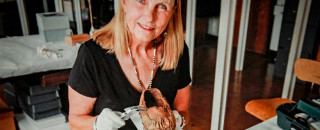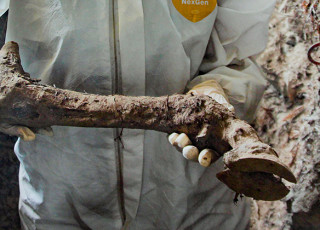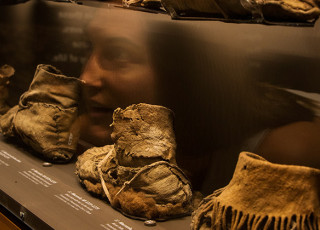Alcohol, Leather & Time
By Michael Mozdy
First discovered in 1930, the Promontory Cave moccasins in NHMU’s anthropology collection are one of the true treasures of the American West. But they didn’t always resemble a treasure. Julian Steward’s 1930-31 excavations yielded so much material – including 250 moccasins and moccasin parts – that these sat in open wood trays for 70 years in a state not helpful for study or display.
“With the mashed moccasins and bundles of bison fur, you could not make much sense of what this collection contained,” explains Kathy Kankainen, former Anthropology Collections Manager for the Natural History Museum of Utah.
So in 2001, Kankainen applied for and received a Save America’s Treasures grant from the National Trust for Historic Preservation. We hired Nancy Odegaard, an internationally known conservator to help make sense of the moccasin collection and preserve them for future study. This is the story of how leather, alcohol, and time – as well as an amazing attention to details – came together during the conservation of this collection.
Read the full story of the moccasins in The Promontory Culture: Subarctic Canadian Peoples Living in Utah Caves.
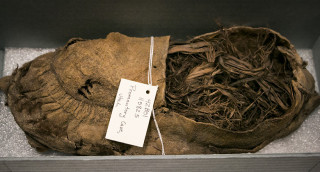
Reshaped Promontory moccasin featuring shredded juniper insole. © NHMU.
Step 1: Inventory, Freeze, and Clean
First, we inventoried and photographed the moccasins. The collection contains many leather parts and partial moccasins as well as full moccasins. Next, we put them in the deep freeze. As part of NHMU’s protocol for any artifact coming into our collections and exhibits, we use a large walk-in freezer. Objects are wrapped in tissue paper and then sealed in plastic to help them avoid “freezer burn” issues like condensation, expansion & contraction, etc. The freezer ranges in temperature from -25°C to -30°C, and we leave our objects inside for a week to kill any bugs and their eggs. This way, we can keep out pests, which pose a significant hazard to collections, especially anthropological collections with textiles and other fibers.
After the freeze, we checked for signs of pests, and gently cleaned them. “Each moccasin stable enough was vacuumed with a dental vacuum where the amount of suction can be carefully controlled,” explains Kankainen. Others were cleaned only with brushes or debris was removed with tweezers.
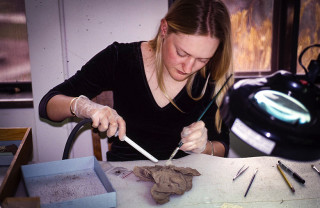
One of the restoration project workers cleaning a moccasin with a dental vacuum and brush. © NHMU.
Our staff learned much in the cleaning and inventory phase. “We learned that more than half of the moccasins had repairs that the people wearing them made, and almost all of the moccasins were heavily worn,” details Kankainen. Over 50 had shredded bark insoles, some of them still reflecting the imprint of a foot. Some were decoratively fringed and one had remnants of quill work. “This is maybe the earliest example of embroidery quill work in the world,” beams Kankainen.
Our team decided that every moccasin and moccasin part would at minimum be cleaned, analyzed, stabilized, and re-housed. But, with Odegaard’s help, some of them would be reshaped into their original form.
Step 2: The Vapor Chamber
The team decided to intensively work on 75 moccasins, based on the condition of the shoes and which ones had the most information to be gained in reshaping. Because the leather moccasins had been buried in the ground and been sitting for centuries unused, they were delicate and could break if moved too much. The first task was to coax the leather into being suppler.
The team created a vapor chamber by putting some isopropyl alcohol in the bottom of an airtight Tupperware container and placing a moccasin on a slightly raised surface above the alcohol. The alcohol fumes would gently penetrate the leather to prepare it for the next step.
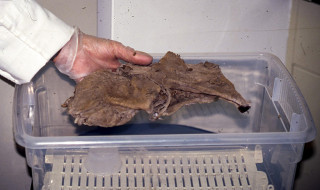
The Vapor Chamber. © NHMU.
Step 3: Alcohol and Manipulation
After sitting overnight in the vapor chamber, moccasins were immersed in a solution of alcohol and distilled water. The water helped to remove excess dirt (the universal solvent!) and the alcohol helped the leather to avoid swelling too much. Some acetone was also used to quicken the drying process. Odegaard determined these ratios individually for each moccasin, using her experience as a conservator.
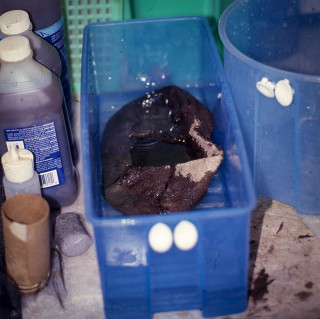
Moccasin being immersed in water and alcohol solution. © NHMU.
After this step came the true hands-on part. Kankainen explains: “Working with gloved hands and under a fume hood, we gently worked the moccasins to smooth out folded areas and slowly manipulate the leather back to its original form.” This wasn’t quick work. Kankainen relates that it sometimes took an entire eight-hour work day for a single moccasin.
Step 4: Support for Form and Drying
The team ingeniously used inserts of many kinds to support the leather while manipulating it and letting it dry. These forms were used to keep the mocs in a shape as if a foot and ankle were inside. They included foam, balloons, hair clips, and rods.
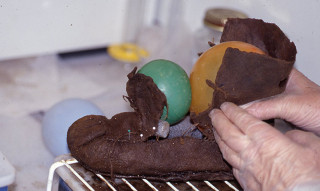
Balloons and foam inserts to help the moccasin hold its shape. © NHMU.
When they felt like they had done as much as they could, the moccasins were moved to the lab table where the final phases of manipulation, support, and drying happened. “The leather would tell you when it reached its original spot,” Kankainen claims. “We would work it for a long time, just tiny increments back and forth, and you could feel when it was done moving and didn’t want to go past the form it had previously occupied.”
Step 5: A Suitable Home for the Moccasins
The team created custom boxes for each moccasin and the moccasin parts using a type of acid-free corrugated board and a soft white fabric ribbon material commonly used by museums for archival work. These were made with drop-down sides to allow easy access without having to touch the artifacts.

© NHMU.
All the boxes are now kept in our climate- and humidity-controlled collections room, in enclosed steel cabinets. When Kankainen opened the steel cabinets for me to photograph the moccasins, we were met with the unmistakable scent of smoke. Kankainen closed her eyes and inhaled with a smile. “You can still smell the fires by which they tanned the hides,” she said. Undoubtedly they also picked up years’ worth of smoke from the caves where these people lived and ate as well. It was a remarkable sensation to recognize the scent and yet know that it was from centuries earlier.

© NHMU.
A Deeper Understanding of the Moccasins and the People Who Wore Them
The moccasins were winter shoes. Many still have deer hair or bison fur from the original pelt on the inside of the shoe, while others have padding of hair, fur, or shredded juniper bark as an insole. Even the low moccasins had stitching holes where there were once uppers attached.
What’s more, the people who wore them used them well. Odegaard relates, “Most of the fragments had been reworked many times, indicating frugality and ingenuity with the leather supply. It appeared that these moccasins were worn until sole holes made it necessary to change foot. Then as wear progressed, the holes were folded up so that a smaller foot could wear them.” The uppers appeared to be re-used as well.
“The leather workers who made these moccasins were very good at their craft,” states Kankainen. We reached out to Nancy Fonicello, a professional artist who works with hide, beads, and quill work and repairs and replicates museum objects. She constructed two pairs of moccasins based on detailed study of the ones in our collection. The pair below is a faithful reproduction of the original porcupine quill moccasin currently on permanent display at NHMU and reveals the true artistry of the objects from the Promontory Phase peoples.
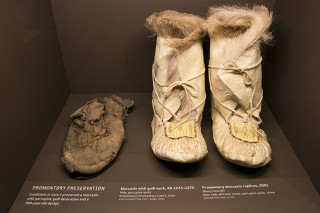
Original and replica moccasins on display at NHMU. © NHMU.
Some of the moccasins have been dated, and the majority of them fall right around the year 1275 A.D. Through this conservation work, we’ve confirmed Steward’s observations: the moccasins are completely unique compared to the others of the time found in the Great Basin region, like hock moccasins and Fremont moccasins. Read the full story of the moccasins in The Promontory Culture: Subarctic Canadian Peoples Living in Utah Caves.
Kankainen still glows with the memory of the work she and her team did fifteen years ago. “It was amazing to witness the metamorphosis as the moccasins almost rose from the ground, embedded with salt and dirt, and came back to life.” Thanks to her work, the fully analyzed and accessible collection can help researchers understand the style and technique of the creators and learn much more about the people who made and wore them.
“Footwear, I believe, is probably the most human of artifacts,” says Kankainen. “It’s very personal and emotional to feel the shapes on the soles where toes pressed and worn spots at the heel or ball of the foot.”
Odegaard agrees. “It felt as if an individual person’s foot and particular walking style was being revealed,” she says. “The brain-tanned leather of each moccasin actually carried the memory of the foot that wore it. The treatment allowed the uniquely individualized foot shapes, wear patterns, and repair areas to be seen and preserved.”
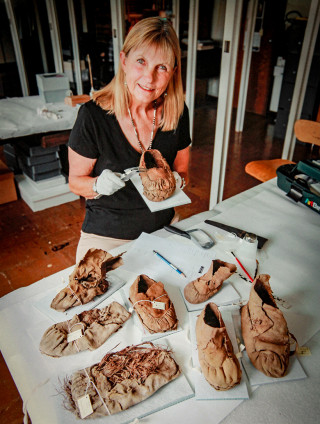
Kathy Kankainen with restored Promontory moccasins. Photo: Eric Kankainen.
Kankainen and the NHMU team are very grateful for the help of Nancy Odegaard in helping to conserve the moccasins and the artistry of Nancy Fonicello in creating beautiful replicas of them.
Don't miss the entire three-part series on NHMU's Promontory moccasins:
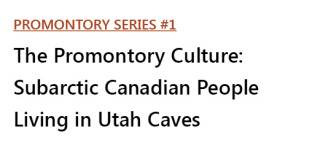
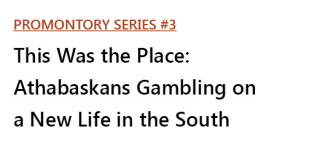
Michael Mozdy is a Digital Science Writer for The Natural History Museum of Utah, a part of the University of Utah in Salt Lake City. Our mission is to illuminate the natural world and the place of humans within it. In addition to housing outstanding exhibits for the public, NHMU is a research museum. Learn more.
